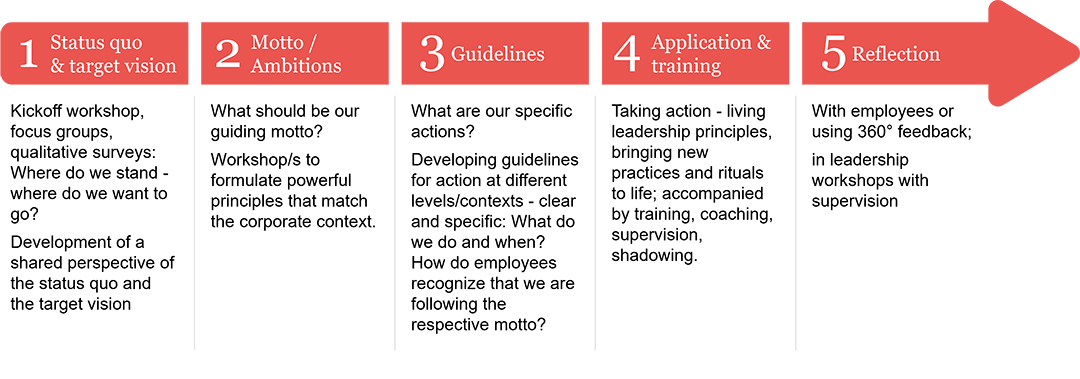Leadership principles for sustainable corporate success
- According to which principles do we lead in our organisation?
- Do the established leadership principles of our organisation reflect our culture?
- How would someone recognise a top leader in our company?
Good leadership - designed and defined together - is the bedrock of a successful organisation. It needs a road map which provides orientation and support in difficult situations as well as for young or new leaders. Leadership principles are only ever as good as the way they are lived. They remain powerless in the absence of understanding, and it takes a lot of energy to implement them if they contradict the culture in which they are practiced.
More and more, leadership is shared among several people - whether in lateral leadership situations, in agile organisations, or within changing project teams. On the one hand, this calls for everyone to be flexible enough to take on different roles, regardless of their function, and on the other hand, it requires a shared understanding as to what leadership is all about.
It has always been the case that good leadership should attract rather than create pressure: Until recently, companies did get away with the latter fairly well. However, as the current labor market situation shows, attracting and retaining the best people in the long term requires fascination, cooperation, development opportunities, room for self-fulfillment, and a healthy work-life balance. This, in tandem with the pressure to deliver results and the huge challenges in the overall corporate environment, pushes leaders to their limits. There is a need for a framework - based on coherent leadership principles and a leadership culture that is lived collectively - one that offers orientation and provides support in prolonged crises in order to be able to act constructively and in a context-appropriate manner. Clear leadership principles that are understood, internalised, and authentically embraced by all managers are the basis on which new ways of working together across all hierarchies can thrive and grow.
Levels of Development

* Levels of development, inspired by Dilt's model of logical levels
To understand the starting point, all levels have to be taken into account, in which case development usually begins most consistently “right at the top”.
1. Context
The context forms the foundation of the pyramid and encompasses the environment in which an organization or individual operates. This includes external factors such as market conditions, societal trends, and technological developments that influence development. The context defines the framework and sets the challenges and opportunities available.
2. Processes, Structures, Tools
The next level includes the processes, structures, and tools. These elements describe how work is organized and carried out within the organization. Processes define workflows, structures establish organizational hierarchy and responsibilities, and tools are the instruments and technologies used to support work. Efficient and effective processes, structures, and tools are crucial for operational excellence.
3. Actions
Actions are the concrete activities and behaviors performed by members of an organization or individuals in the context of their work. This level describes how tasks are executed daily and what measures are taken to achieve goals. Actions are the visible outcomes of processes and structures.
4. Competence
Competence encompasses the skills, knowledge, and abilities required to perform the defined actions effectively. This level emphasizes the importance of continuous education and development to ensure that individuals and teams possess the necessary competencies to succeed in their tasks.
5. Values
Values represent the fundamental beliefs and principles that guide behavior and decision-making within an organization or individual. They are the moral and ethical guidelines that shape the culture and work environment. Values play a central role in creating a coherent and motivating atmosphere.
6. Identity
Identity refers to the self-concept and the image that an organization or individual has of itself. It includes the mission, vision, and long-term goals that drive actions and strategies. A clear and strong identity fosters a sense of belonging and alignment with common objectives.
7. Meaning
At the top of the pyramid is meaning, which represents the highest level of motivation. It is about finding a deeper purpose and significance in work and actions. Meaning gives people the feeling that their work is important and makes a positive contribution. It is a powerful motivator and promotes engagement and satisfaction.
Approach
Ever since 5P was founded, we have carried out a multitude of development processes for leadership principles and leadership competencies, each one designed specifically for the respective organisation.
Here is one possible approach to establishing leadership principles:

1. Status Quo & Target Vision
In this first step, the current state of the organization or team is analyzed (status quo). It is important to understand where the organization currently stands, its strengths and weaknesses, and the challenges it faces. Based on this analysis, a target vision is developed that describes the desired future state. The target vision should be clear and inspiring to provide direction for the change process.
2. Motto / Ambitions
After defining the target vision, it is important to establish a motto or ambitions that summarize the vision and goals of the change. The motto serves as a guiding star and motivational force that leads the team through the change process. It should be concise, catchy, and inspiring to engage and motivate the employees.
3. Guidelines
In this step, concrete guidelines are developed that establish the principles and values the leaders and employees should follow. These guidelines serve as a framework and orientation for daily actions and decision-making. They should be clear, actionable, and aligned with the organization's overarching goals.
4. Application & Training
The guidelines and principles must now be put into practice. This is done through targeted application and training programs that help leaders and employees integrate the new principles into their daily work. Training sessions, workshops, and coaching are important elements to ensure that employees acquire the necessary skills and knowledge to implement the guidelines successfully.
5. Reflection
The final step in the process is reflection. This involves reviewing and evaluating the progress of the implementation. It is important to regularly reflect on whether the defined goals have been achieved, what challenges have arisen, and what adjustments are necessary. Reflection enables continuous learning and improvement of the process of establishing leadership principles. Feedback loops and evaluation methods are essential here.
The development process is a collaborative effort that incorporates the corporate context and the maturity level of the current leaders as well as the goal that has been defined together. We develop that goal based on guiding questions.
- Where are we leading our employees and why - and who are they or what do they need to get there successfully?
- What is the style we want to convey to do justice to our goal?
- Which personalities are driving our organisation forward, who are the key players, and how do we deal with the typical challenges?
- How do we make decisions?
- How do we establish or set goals?
- How do we handle conflict and how do we advance the development of individual people or teams?
- What error culture do we need in order to deliver performance and promote innovation and creativity?
- How do we communicate in everyday situations and in the spirit of the strategy?
- How does a new employee recognise the prevailing leadership culture?
The more openly and honestly leadership principles are discussed and worked on, the more likely a leadership culture will develop from this foundation. This requires honest monitoring and lived habits or rituals which act as a compass for the individual leader and can be experienced in day-to-day life. For many leaders, this process yields new insights and also new challenges that call for personal development and new leadership competencies. And this is exactly why the process cannot end at this point. On the contrary, binding goals for development and measures have to be established. Furthermore, regular reflection loops which focus on the topic of leadership in the annual cycle are essential to become effective.
